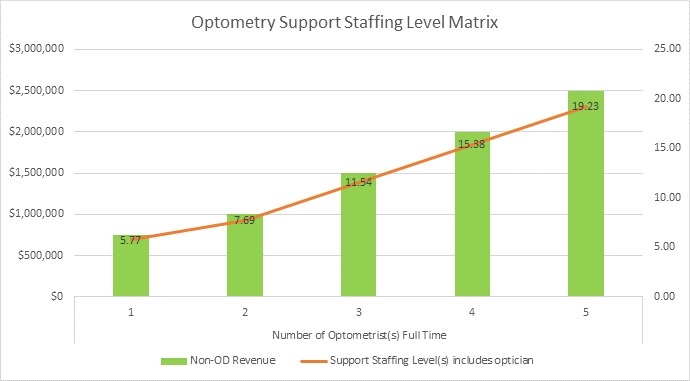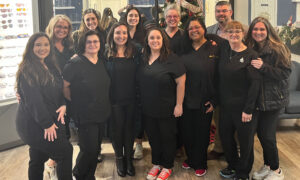By Eric Rettig, OD

Jan. 2, 2019
Adding a new staff member can be perilous. You worry about whether they will be able to do the work assigned to them, and whether your patients and other employees will get along well with them.
In my office, we carefully select new hires, and plan out their training once on the job, so we don’t regret these decisions.
We have 25 non-OD staff. We’ve been above 20 employees for about the past 10 years. The biggest employee increase occurred a few years ago when all of our doctors changed their patient schedules to see more patients. We changed our technician staff to two per doctor to increase efficiency and allow the doctors to see more patients, and to perform fewer of the early parts of the exam.
Our practice has four full-time ODs. Altogether, we perform 8,200-8,400 comprehensive exams per year.

Source: Management & Business Academy
According to the MBA Key Metrics of Optometric Practice, there are four key staffing metrics to keep in mind:
• Staff salary expense ratio should be 18-24 percent of overall practice expenses.
• Revenue per full-time-equivalent (FTE) staff member per hour should equal $80-$83, or annual revenue per FTE staff should equal $130,000.
• One optician per annual sales revenues of $225,000.
Revenue Plus Staff Feedback & Practice Owner Observation
When we consider adding a new staff member we look at whether the hire will be supported by additional revenue generation. That’s exactly what we did, for instance, when we hired more technicians because we knew that doing so would allow us to see more patients.
In addition to crunching the numbers, we keenly observe the workflow of our staff, and note when staff are getting overwhelmed by the work, or are not doing the work up to the quality we expect because they are over-burdened. We also listen when staff tell us they are having trouble managing their workload. In those cases, we will determine whether the numbers support the decision, and if possible, we will accommodate an additional employee.
Other Articles to Explore
Reach Out to Potential Employees on Social Media
Online job sites, such as Monster and Local Eye Site, are a great resource in recruiting applicants for open positions.
In addition, we’ve found that our practice Facebook page, and other social media platforms, are great, and no- or low-cost ways to get the word out that we are looking for a new employee.
We used to advertise for open positions in print newspapers, but found it to be costly and not as effective as advertising on online job boards and social media.
It’s OK to Delegate Hiring to Office Managers
Our office managers handle most of the hiring. They review all resumes/applications and decide who comes in for interviews. If they feel a potential employee shows promise, they usually bring them around to meet all the doctors.
Ask for Application Plus Resume
There’s no use reinventing the wheel every time a new staff member needs to be added. We have created a standard job application, which asks for the information typically asked for on such applications, including past work experience, preferences for a new job and references.
We also expect a comprehensive and well-organized and well-presented resume. It can be a red flag when an applicant can only answer questions on an application, and has not taken the time to create a thorough and polished resume and cover letter.
We’re careful about giving preference to the applications and resumes that include the most detailed information about past experience, and goals for a new job.
Focus on In-Person Interviews
If the application and resume look good, our office manager calls the applicant to come in for an in-person interview. We prefer face-to-face interviews. The office managers ask applicants about their strengths, weaknesses, what interested them in working at our office, and about their future plans. They also ask situational questions about handling difficult patients and on-the-job challenges.
We either have our office managers ask for examples of how the applicant handled stressful work situations in the past, or we have them pose a hypothetical situation, and ask the applicant how they would approach it.
You Can Do Second Interview Same Day, Right After the First
Rather than having the applicant come back to the office to get the approval of the doctors, our office manager will decide toward the end of the first interview whether the applicant is promising enough to have them come to the back of the office to meet the doctors.
Doing this speeds up the process, and keeps a promising applicant from slipping away and getting hired by another business they are interviewing with. It also allows for the office manager to easily build on the conversation they already started with the applicant, looping the doctors into that same conversation. When the doctors meet, and interact with, the applicant, the office manager can see whether their initial positive assessment was right, or whether the applicant is not a person the doctors in the office will work well with.
Get Perspective of Support Staff Members Who Will Work with New Hire
In addition to seeing how well a potential applicant interacts with doctors, it’s helpful to get feedback from the support-staff members who will work with the new employee.
In recent years, we have started introducing promising applicants to not just the doctors, but the support-staff members they would be working with. If the support-staff employees, who meet the prospective new hire, have negative feelings about the applicant, it is unlikely we would hire them.
Hire for Personality Only Some of the Time
We feel there are certain positions in the office that definitely benefit from having a previous skill-set in the field. We have hired based on personality, which works fine as long as there are other knowledgeable staff members who can help train the new employee appropriately.
For example, over the last year, two of our most experienced staff in optical fell ill around the same time and were no longer able to work. We were left with a less experienced staff that didn’t have as much knowledge or experience. At that point, we knew our replacement hires had to be experienced in optical (which we knew would take more time to find and come at a higher price).
Determine Your Benchmarks When Negotiating Salary
Salary is often negotiable, and we usually approach it on a case-by-case basis. Obviously, someone with more experience who works in a more challenging part of the office can demand a higher pay.
For most positions, we try to see what other staff in similar positions are paid, as well as what they may be making at their current job. The biggest lesson would be that obviously costs for quality staff has gone up, and it is not worth it to nickel and dime over pay. In the big picture, paying more for experience and knowledge can pay off in the long run.
Use a Probationary Period for New Employees
We give new employees a 90-day probationary period. During that time they train and learn the position they’ve been hired for. After 90 days, we review how that time went with them, highlight things we’d like them to focus on, and sometimes there are potential salary increases if we feel job performance has exceeded our expectations.
 Eric Rettig, OD, is a partner with Mountain View Eye in Altoona, Penn. To contact him: ericmrettig@gmail.com
Eric Rettig, OD, is a partner with Mountain View Eye in Altoona, Penn. To contact him: ericmrettig@gmail.com

























